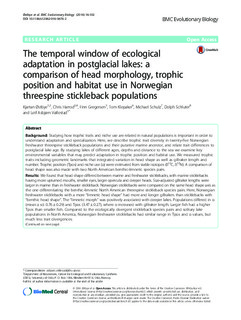| dc.contributor.author | Østbye, Kjartan | |
| dc.contributor.author | Harrod, Chris | |
| dc.contributor.author | Gregersen, Finn | |
| dc.contributor.author | Klepaker, Tom | |
| dc.contributor.author | Schulz, Michael | |
| dc.contributor.author | Schluter, Dolph | |
| dc.contributor.author | Vøllestad, Leif Asbjørn | |
| dc.date.accessioned | 2016-11-02T12:16:51Z | |
| dc.date.available | 2016-11-02T12:16:51Z | |
| dc.date.issued | 2016 | |
| dc.identifier.citation | Østbye, K., Harrod, C., Gregersen, F., Klepaker, T., Schulz, M., Schluter, D., & Vøllestad, L. A. (2016). The temporal window of ecological adaptation in postglacial lakes: A comparison of head morphology, trophic position and habitat use in Norwegian threespine stickleback populations. BMC Evolutionary Biology, 16(1). doi: 10.1186/s12862-016-0676-2 | nb_NO |
| dc.identifier.uri | http://hdl.handle.net/11250/2418924 | |
| dc.description.abstract | Background:
Studying how trophic traits and niche use are related in natural populations is important in order to
understand adaptation and specialization. Here, we des
cribe trophic trait diversity in twenty-five Norwegian
freshwater threespine stickleback populations and their
putative marine ancestor, and relate trait differences to
postglacial lake age. By studying lakes of different
ages, depths and distance to the sea we examine key
environmental variables that may predict adaptation in
trophic position and habitat use. We measured trophic
traits including geometric landmarks that integrate
d variation in head shape as well as gillraker length and
number. Trophic position (Tpos) and niche use (
α
) were estimated from stable isotopes (
δ
13
C,
δ
15
N). A comparison of
head shape was also made with two North American benthic-limnetic species pairs.
Results:
We found that head shape differed between marine and freshwater sticklebacks, with marine sticklebacks
having more upturned mouths, smaller eyes, larger opercula and deeper heads. Size-adjusted gillraker lengths were
larger in marine than in freshwater stickleback. Norwegian sticklebacks were compared on the same head shape axis as
the one differentiating the benthic-limnetic North American threespine stickleback species pairs. Here, Norwegian
freshwater sticklebacks with a more
“
limnetic head shape
”
had more and longer gillrakers than sticklebacks with
“
benthic head shape
”
.The
“
limnetic morph
”
was positively associated with deeper lakes. Populations differed in
α
(mean ± sd: 0.76 ± 0.29) and Tpos (3.47 ± 0.27), where
α
increased with gillraker length. Larger fish had a higher
Tpos than smaller fish. Compared to the ecologically divergent stickleback species pairs and solitary lake
populations in North America, Norwegian freshwa
ter sticklebacks had similar range in Tpos and
α
values, but
much less trait divergences.
Conclusions:
Our results showed trait divergences between th
reespine stickleback in marine and freshwater
environments. Freshwater populations diverged in trophic ecology and trophic traits, but trophic ecology was
not related to the elapsed time in freshwater. Norwegian sticklebacks used the same niches as the ecologically
divergent North American stickleback species pairs. Ho
wever, as trophic trait divergences were smaller, and not
strongly associated with the ecological niche, ecologica
l adaptations along the benthic-limnetic axis were less
developed in Norwegian sticklebacks. | nb_NO |
| dc.language.iso | eng | nb_NO |
| dc.publisher | BioMed Central | nb_NO |
| dc.subject | Adaptive radiation | nb_NO |
| dc.subject | Natural selection | nb_NO |
| dc.subject | Ecological niche | nb_NO |
| dc.subject | Stable isotopic analysis | nb_NO |
| dc.subject | Isostatic uplift | nb_NO |
| dc.subject | Holocene | nb_NO |
| dc.subject | Pleistocene ice sheet | nb_NO |
| dc.subject | Benthic-limnetic stickleback species pairs | nb_NO |
| dc.title | The temporal window of ecological adaptation in postglacial lakes: a comparison of head morphology, trophic position and habitat use in Norwegian threespine stickleback populations | nb_NO |
| dc.type | Journal article | nb_NO |
| dc.type | Peer reviewed | nb_NO |
| dc.subject.nsi | VDP::Agriculture and fishery disciplines: 900::Fisheries science: 920 | nb_NO |
| dc.source.volume | 16 | nb_NO |
| dc.source.journal | BMC Evolutionary Biology | nb_NO |
| dc.source.issue | 102 | nb_NO |
| dc.identifier.doi | 10.1186/s12862-016-0676-2 | |
